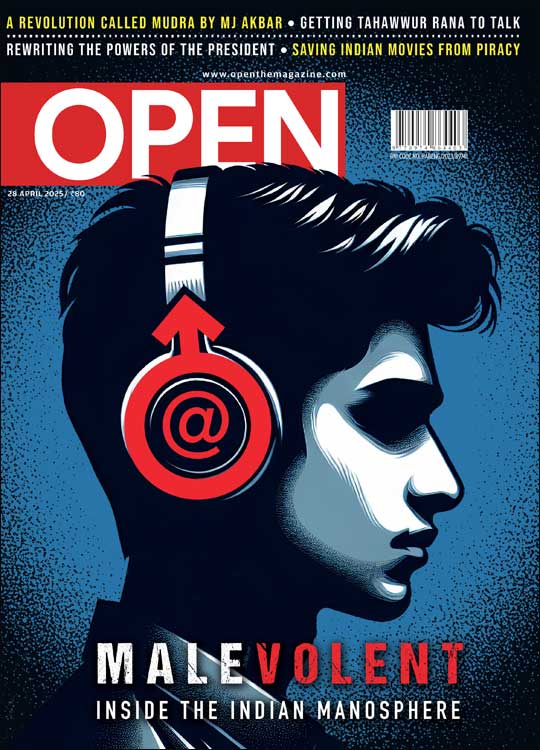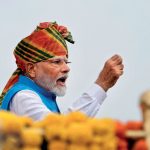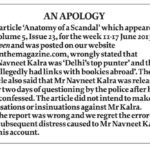The Dangling Conspiracy Question
Twenty-one years after Rajiv Gandhi’s assassination, the mysterious Multi Disciplinary Monitoring Agency, set up to find out who was behind the conspiracy, has provided no answers
 Shahina KK
Shahina KK
 Shahina KK
|
17 Sep, 2011
Shahina KK
|
17 Sep, 2011
/wp-content/uploads/2015/11/rajiv1.jpg)
21 years after Rajiv’s killing, the Multi Disciplinary Monitoring Agency set up to probe the conspiracy, has no answers
On 18 August 2011, J Mohan Raj, a former inspector with the Central Bureau of Investigation (CBI) went for an unusual meeting in Vellore jail. He asked for and received permission to come face to face with three men he had tortured 20 years ago. He had been a member of the special investigation team (SIT) that probed the assassination of Rajiv Gandhi. Having heard that an execution date had been set for Perarivalan (aka Arivu), Murugan and Santhan, Mohan Raj had wanted closure. Shown into their presence in jail, he stood still for a moment, uncertain what to do next. Then Arivu came forward and hugged him. Santhan and Murugan followed. He was overcome but had no intention of apologising. “Who am I to apologise? What is the point in apologising? I requested Arivu to try to understand me. I told him if he were in my place, he would have done the same thing. They clearly remember the agony and torture they went through when they were in custody. They even remember the names of all the officers and what had been done to them. I only asked them to forget everything. Arivu told me that he has no problem with me at all,” he says.
Mohan Raj does not think the three are innocent. He is certain they were involved in the assassination but only as small fry. But that they were tortured, he maintains, is beyond doubt; he himself is living proof of the fact. “The SIT head Karthikeyan claims in his book (The Triumph of the Truth, published 2004) that no third degree torture was used against the accused. That is a blatant lie. I participated in it. I am ready to disclose it in any court. I don’t mind being punished by the law of the land.”
That the confessions were obtained under torture is important because of the Act (TADA) under which the accused were held. Under TADA, a confession to the police is admissible as evidence and it was almost exclusively on the confessions of the accused that they were held guilty. As the Supreme Court judgment itself said: “To establish the charge of conspiracy to commit the murder of Rajiv Gandhi, reliance is placed mainly on seventeen confessional statements made by the accused persons recorded under section 15(1) of the TADA act.” (Para 658, page 2843)
Mohan Raj’s assertion that these were small fry holds the implication that there are big fish involved, who have not been named. Twenty years have passed since the assassination. Here’s the broad sequence of events that followed: investigation by the CBI Special Investigation Team (SIT); the submission of its chargesheet; trial by the TADA court; final judgment by the Supreme Court; a mercy petition before the President; its final rejection; the setting of a date of execution; and a plea (granted) to set off the execution date by eight weeks. That’s where it currently stands. During the labyrinthine course of these investigations, a bunch of conspiracy theories have also done the rounds. Tamil Nadu Congress leaders, the DMK, M Karuna- nidhi, godman Chandraswami, and many others have been mentioned at some point or another. In a rather telling statement, VP Singh once noted that not a single Congress leader had died along with Rajiv Gandhi.
The Jain Commission, set up to look into the larger conspiracy, had called for further investigations into the conspiracy angle. It led to the CBI setting up a Multi Disciplinary Monitoring Agency (MDMA) in 1998. The Government Order, issued by the Ministry of Personal Affairs, dated 2 December 1998, states that the tenure of the agency would be two years. Twelve years have passed since, the agency has sought renewal twelve times and there is still no clarity on who really conspired to kill Rajiv Gandhi. Through the whole course of its existence, the MDMA has failed to find anything significant or make a real breakthrough.
The MDMA has been submitting reports in the TADA Special Court in Chennai every three months. What are the contents of these reports? What conspiracy is the MDMA still investigating in the 21st anniversary year of the assassination? Why does this agency still exist? Why does a team of CBI officers draw salaries for a task pending for 12 years? I travelled to Chennai to find some answers. I was told by local journalists that the MDMA office was in Adyar, near the Malligai building that was once the headquarters of the SIT that probed the assassination. I found no such office there. A police officer came to help, but he hadn’t even heard of the MDMA. By then, I had managed to get the landline number of the MDMA office in Chennai. The person who took the call refused to tell the location of the office. “I am only a junior officer and cannot disclose anything, not even the location of the office,” he said. I visited the CBI office in Nungambak- kam, but they seemed equally clueless.
After pounding the pavements of Chennai for half a day, I finally managed to meet an MDMA officer in his office. S Eeswara Moorthy, Superinten- dent of Police, technically belongs to the MDMA but works in the CBI’s vigilance and anti-corruption wing. “We are still on the job, I am not supposed to talk to the media,” he said. But he confirmed the MDMA submits reports every three months in the TADA Court.
Making the MDMA accountable has been a pet project of Mohan Raj since his voluntary retirement. He has repeatedly sought information from the CBI on the MDMA’s functioning and findings, and most of his applications have been dismissed citing a TADA court directive to conduct all proceedings ‘in camera’. “The people of this country have a right to know what the MDMA has done so far and their findings, if any. There are many loopholes and omissions in the investigation. I’ve tried several times to point this out to other SIT team members, but I’ve failed,” he says. In 2006, Mohan Raj finally got some answers, via an RTI application. This is what he found then: there are 40 officers working in the MDMA; they have so far made 15 foreign trips to investigate the ‘international conspiracy’ angle and Rs 12 crore of public money has been spent on the agency. “Five years have passed since I got that information. How much more public money must have been spent without any significant output?” he asks. A few other officers, closely related to the investigation, agreed with Mohan Raj but weren’t willing to go public.
The Government Order on the MDMA’s constitution clearly states the terms of reference of the agency and the conspiracy theories it had to investigate. There are four units headed by officers of the rank of SP under the Joint Director of the CBI.
» The first unit was to probe the claim of Mahant Sewa Das, president of Akali Dal (Pheruman) who had testified to the Jain Commission that in January 1991 he had informed former Prime Minister Chandra Shekhar about a plot by Khalistan activists to kill Rajiv Gandhi
» The second unit was to investigate the complicity and alleged involvement of godman Chandra- swami, arms dealer Adnan Khashoggi and politician Dr Subramanian Swami
» The third unit was to probe the role of LTTE operative Kumaran Padmanabhan, former DMK minister and Member of Parliament Subbulakshmi Jagadeesan and DMK leader M Karunanidhi
» The fourth unit was to look at the delay in decoding wireless messages sent between LTTE cadres
“I have absolutely no idea what they have found so far,” says K Raghothaman, former chief investigating officer of the SIT and an MDMA member for one year. “The head office is in Delhi. Here our task was only to follow their instructions—like cross-examining some witnesses.”
Raghothaman admits to some omissions in the assassination investigation. “I must confess certain things never came to my notice. I found out about it years later, after the chargesheet had been submitted,” he says. One of them was a videotape that had captured the bomb blast. The Intelligence Bureau has secured the tape. It is referred to in a letter written by then IB Chief MK Narayan to then Prime Minister Chandra Shekhar. Shockingly, Raghotha- man, despite being the SIT’s Chief Investigating Officer was not given the tape. “I came to know about it from the Verma Commission report. Annexure 34 of the report has a reference to Narayan’s letter, where he says he will come up with a further report on the videotape. I was taken aback to see this reference. I immediately contacted DR Karthikeyan, the SIT chief. He said he’d got a tape from the CBCID (Crime Branch Crime Investigation Department) but not from the IB. I still don’t know whether the tape MK Narayan had referred to was the same tape mentioned by Karthikeyan. I still don’t know why I was not informed of the tape. It remains a mystery.”
Raghothaman says that initially there were attempts to convince the SIT that the LTTE was not involved in the plot. “Within a week of the assassination, there was a high level meeting in Delhi in which top RAW officials were present. Right from the beginning, RAW had maintained that it was not the LTTE that was behind the assassination. One official said he was sure because he had a mole in the LTTE. In the meeting, he was forced to disclose his source in the LTTE. He said it was Kittu [Sadasivam Krishnakumar alias Kittu was one of the first LTTE commanders and a close relative of Veluppillai Prabhakaran. In 1993, he killed himself by blowing up the ship he was sailing in after being surrounded by the Indian Navy while returning from
Thailand. It was impossible for Raghothaman or anyone to believe that he could be a mole because he and Prabhakaran were effectively the LTTE] Can you imagine our shock and embarrassment? There was a joke doing the rounds in intelligence circles at the time that the LTTE must have a mole in RAW and not the other way round,” says Raghothaman
The MDMA’s constitution specifies that it has to look into the role Karunanidhi played. The Jain Commission had made serious allegations against the DMK and its chief M Karunanidhi for having close contacts with the LTTE. Its report (Volume vii, pages 941 & 944) observed: ‘From the evaluation of the material, the conclusion is irresistible that there was a tacit support to the LTTE by Shri M Karunanidhi and his Government and law enforcement agencies.’ Raghothaman agrees with the observation. “Our efforts to examine Karunanidhi were discouraged. All efforts to examine him and Congress leaders in Tamil Nadu were scuttled,” he says. The MDMA too has not revealed anything about Karunandhi or the DMK in this regard.
Both the SIT and MDMA have also failed to provide the answer to a crucial question—who made the belt bomb Dhanu wore and where was it made? “I agree the SIT couldn’t find the answer,” says Raghothaman. In the initial stages of the investigation, it was believed that Perarivalan had made the belt bomb because he held a diploma in electronics. He had handed over a 9 volt battery to Sivarasan, who masterminded the assassination, but the SIT could not prove his involvement beyond handing over the battery. Nor could it produce any concrete evidence of his involvement in the conspiracy. The team couldn’t even prove that the same battery had been used in the belt bomb. “Arivu had close contact with Sivarasan, hence our inference that he had prior knowledge of the plan. The act is the evidence for such an inference,” says Raghothaman. Should somebody be hanged on the basis of such an inference? “I am against the death penalty; I will be the happiest person if they come out,” he says.
He refuses to comment on the TADA court’s judgment awarding death to Santhan, Murugan and Arivu, which was later upheld by the Supreme Court. The Supreme Court was convinced of Arivu’s involvement. In the words of the judgment: “Circumstances rather show that Arivu (A-18) was in the thick of conspiracy. He knew that to explode the IED power source would be 9 volt battery and that is why he purchased battery of that power and which was ultimately used in exploding the device killing Rajiv Gandhi and others. Mr Natarajan also said that the version of Arivu (A-18) that this battery was used for explosion of the IED was his knowledge derived after the explosion cannot be accepted.”
Justice H Suresh, former judge of the Bombay High Court, was highly critical of the judgment in the foreword to Perarivalan’s book, ‘An Appeal from Death Row’. Justice Suresh wrote: ‘Where is the evidence for the charge of conspiracy? The evidence clearly indicates that only Dhanu, Sivarasan and Subha had directly involved in conspiring the murder. In the case of the rest of the accused, the only evidence was the confessional statement recorded under TADA, which could not have been admissible in respect of the charges under Indian Penal Code. The only evidence against Arivu was his buying a 9 volt battery cell.’ He also expresses embarrassment over the naiveté of judges in assuming that the accused have voluntarily admitted their guilt, as if the atmosphere in a police station could be so free and fair.
After retirement, Mohan Raj, who once tortured the three condemned men, became an active campaigner against their death sentence. He is sure that all the five people sentenced — three to capital punishment and two to life imprisonment — are tools of a larger conspiracy. The petitions he filed in the TADA court and Chennai High Court were dismissed with the comment that he should have brought these facts to the notice of his superior officers during the course of the investigation. He says he has tried to bring to public attention all the lapses in investigation, but has “failed miserably”.
There are several questions untouched by the SIT and trial court. It is time the MDMA had answers to some of these questions:
» Why were the IB and RAW reluctant to link the LTTE to the assassination?
» Where is the videotape mentioned by MK Narayan in his letter?
» What prompted the IB brass to prevent the SIT from visiting Colombo for investigations?
» What was Chandraswami’s involvement, as referred to by the Jain Commission, in the death of Rajiv Gandhi?
» Why did the CBI fail to interrogate Kumaran Padmanabhan, a top LTTE leader, who is in Sri Lanka?
» What is the role of Karunanidhi in the whole episode?
» What was the reason for the SIT’s failure to interrogate Congress leaders in Tamil Nadu?
» What was the reason for the absence of security measures such as a metal detector on the women’s section of the crowd in Sriperumbudur on the day of the assassination?
» What is the outcome of the 15 foreign trips made by MDMA officials so far?
Three people are about to be killed by the state. There is no better time to clear the mysteries surrounding the conspiracy. And if the MDMA is unable to provide the answers, then it is time for the Government to admit it doesn’t know.

/wp-content/uploads/2025/04/Cover-Manosphere.jpg)











More Columns
PM Modi vows to pursue Pahalgam terrorists, backers to the ends of the earth Ullekh NP
The Best of IPL 2025 Aditya Iyer
India cancels visas to Pak nationals, asks forces to stay alert Ullekh NP